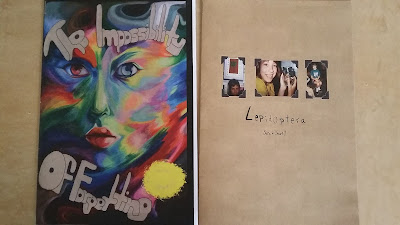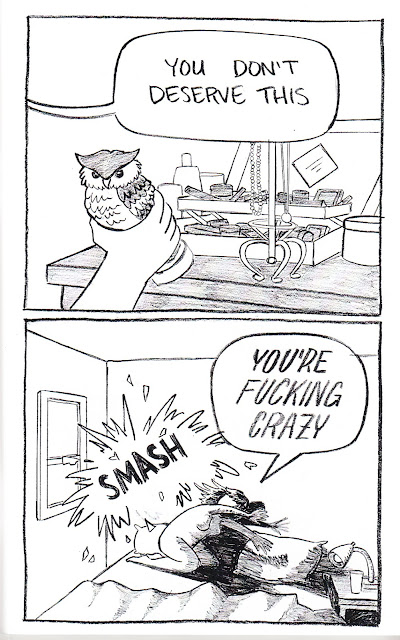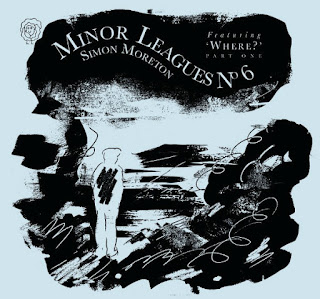(Editor's Note: Sara Jewell is a frequent contributor to YCE)
There’s an interesting quality to Sara Jewell’s comics work, particularly in her approach to the flow of time, how memories are represented, and how they start to fade and break apart. I’ve had the chance to read two of Sara Jewell’s comics, The Impossibility of Forgetting and Lepidoptera and I’ve been taken aback by them. The Impossibility of Forgetting is striking in how narratively experimental it gets while Lepidoptera’s inherent sadness stunned me.The Impossibility of Forgetting is a personal story about loss, the erosion of relationships, and time. As readers, we feel the passage of time and understand how it is unfolding at an accelerated pace. We witness Jewell’s remembering a friend that disappeared from her life over time. We harken back to her memory and conversations between them. The memories Jewell is alluding to are from long ago. They’re improperly recalled and slowly vanishing from existence. What must have really occurred is now a blur, like remembering something a friend said years ago that made everyone laugh, but not really remembering the context, who was there, or why. It’s an interesting look at memory and how time transforms it over time.
Another, perhaps even more interesting aspect of this comic is that this slow and stretched passage of time appears to be an unrelated consequence of the complexity of making comics. Comics are labor intensive and it requires time to plan, write, and illustrate a comic, even a short one like this. While reading, there was this really interesting push and pull between the urgency of the story about friendship and loss and what we see on the pages. It’s as if the mind of Jewell was running faster than her drawing hands. It’s like following a train of thought, it leaves the reader to complete the piece where there might be a gap. It also helped to hammer home the theme of the comic, that time is fleeting, memories are inconsistent and loss happens to us, whether it’s losing friends or our own faculties. It’s a surprisingly deep comic for only an 8-page minicomic.
Jewell also brings this sort of energy to her art by using a sort of “collage-panel” for lack of a better term. Each page of The Impossibility of Forgetting is divided around these memories and how they curve and fold in additional layers or panels on top of what we see. There’s a striking image of a woman lying down, and there is a single panel featuring a teacup blocking the full view of the subject. It’s like memories appearing on top of other memories, distantly related. It helps tell the story and is also an interesting visual trick
Lepidoptera, on the other hand, is a comic about suffering and is a much more traditional narrative comic. It weaves an interesting tale of depression, childhood obsession, and psychosomatic and undiagnosed disease. It’s an autobiography of someone who has suffered and has caused suffering; suffering from depression, inflicting pain on an insect. Jewell’s juxtaposition of these two elements, the pain of depression and the pain of hurting, combines visually using a butterfly motif. There’s a nice symbolic link between the butterflies, trapped in a jar to slowly suffocate, and someone with depression, also trapped in a different space, unable to get out and suffocating. Lepidoptera juggles these thematic elements. , The pace is much slower in this book. The “train of thought” pacing of The Impossibility of Forgetting is replaced with a more deliberate dual perspective in Lepidoptera. It feels more focused.
Lepidoptera is printed on a brown-colored paper which makes the comics even more depressing than the short description made it out to be. Those illustrations of butterflies and fairies look beautiful and should shine, but they are brought down to a level where this sense of wonder is hampered by the background color. It’s quite incredible and unexpected how the theme of depression aligns itself so well with the brown-colored paper.
Jewell, in addition to being a comic artist and illustrator, also reviews comics for this very site. I found it intriguing to see how her understanding of the medium is reflected in her work. Jewell’s description of her own work tends to be somewhat detached but also aims to explain her choices. Here’s what she says about Lepidoptera for example:
"Paracosm utilizes a spectrum of visual and literary techniques. Lepidoptera, perhaps the work’s most traditional narrative piece, employs a conventional voice in memoir, the autographer's retrospective, but juxtaposes this with diegetic dialogue and imagery for a nuanced, multilayered exploration of undiagnosed illness. The visual motif of the butterfly is by turns symbolic and diegetically relevant.”She has an awareness that makes her artistic choices feel both deliberate and somewhat unfocused depending on which technique is at work, but there’s no doubt that she is aware of the goals she’s trying to accomplish. For instance, The Impossibility of Forgetting showcases an interesting way to depict time, but on first reading, this feels almost unfocused. I had to take a step back and return to the beginning of the book, slow down and re-read the story. On second reading, it became more apparent that this was a calculated element to stretch the passage of time, but my first impression left me cold with this comic until a second reading made the comic much clearer. It’s baffling because even with the knowledge that Jewell wishes to explore time, it didn’t fully accomplish that goal. However, in Lepidoptera, Jewell’s choice of the recurring butterfly symbol and the mix of medium (ink and highlighter) works surprisingly well. She mentions in her description of her comic that the materials used, the brown paper and the mix of ink and highlights “allows this story … the greatest degree of tonal depth”. And sure enough, she’s right, I felt it in the reading long before finding this blurb to prepare this review.
Sara Jewell’s understanding of how comics work allows her to make deliberate creative choices for effect, even if it’s not always absolutely successful. It’s always great to see an artist experiment with different techniques to improve their craft.
-----------------------------------------------------


































